View in other NatureServe Network Field Guides
NatureServe
Montana
Utah
Wyoming
Idaho
Wisconsin
British Columbia
South Carolina
Yukon
California
New York
Undulant-winged Grasshopper - Circotettix undulatus
General Description
The following is taken from Helfer (1971), Otte (1981), Vickery and Kevan (1985), and Capinera et al. (2004). This is a large gray to dark gray-brown grasshopper, often more heavily speckled than the other Montana Circotettix species. The tegmina (forewings) lack distinct crossbands with a dark brown spotted base behind the thorax. The head is often paler than the thorax and tegmina. The hind wing disk is blueish or can be pale greenish yellow in some geographical locations and populations. The dark crossband is absent but can be indicated by faint blackish markings at the disk margin. The outer face of the hind femur is brown or gray with faint darker bands. The inner face is black with two pale bands and dorsal stripe. The hind tibia is blue or greenish with a sub-basal pale ring.
Communicative behavior/Crepitation*
As described by Daniel Otte: “…Males perform a two-part crepitation flight consisting of a series of widely spaced snapping sounds (estimated at three to five per second) followed by a rapid buzz (estimated at fifteen to twenty-five per second). During a single flight a male may alternate between two crepitations several times as he flies and circles about an area. Flights may last from a few seconds to half a minute or more and cover hundreds of square meters.” Other observers note that this species produces very loud crepitations which can be heard up to more then 700 feet away, the flight is rapid with a series of looping arches. The sharp clicks are followed by the rapid buzz is very similar to the noise made by a rattlesnake (Otte 1984, Vickery and Kevan 1985).
*Crepitation is the sound produced by grasshoppers making a clicking or snapping noise with their wings when in flight, during courtship, territorial encounters or being disturbed.
Phenology
This species overwinters in the egg stage. Adults occur from mid-July through September (Otte 1984, and Vickery and Kevan 1985).
Diagnostic Characteristics
The following comes from Helfer (1971), Otte (1981), Vickery and Kevan (1985), and Capinera et al. (2004). The body length to the end of forewings is 26-29 mm for males and for females 30-34 mm.
In Montana, the Undulant-winged Grasshopper can visually and by crepitation be confused with any of the other two
Circotettix species, the
Carlinian Snapper Grasshopper (
Circotettix carlinianus) and the
Wrangler Grasshopper (
Circotettix rabula), as well as the
Carolina Grasshopper (
Dissosteira Carolina) and
Crackling Forest Grasshopper (
Trimerotropis verruculata).
Species Range
Montana Range
Range Descriptions
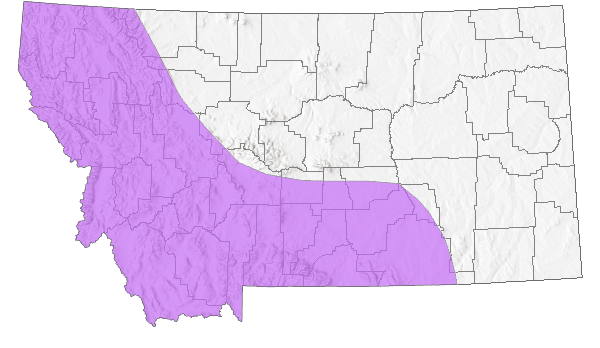
 Native
Native
Range Comments
The Undulant-winged Grasshopper occurs within a relatively small western geographic range from southern British Columbia southward into Nevada and western California, then eastward from central Oregon and Washington to western Montana and northern Wyoming. In Montana it is reported for 10 counties (Newton and Gurney 1956 & 1957, Otte 1984, and Vickery and Kevan 1985).
Observations in Montana Natural Heritage Program Database
Number of Observations: 12
(Click on the following maps and charts to see full sized version)
Map Help and Descriptions
Relative Density
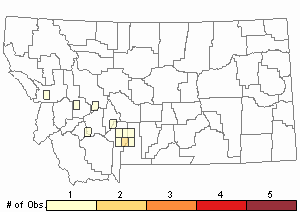
Recency
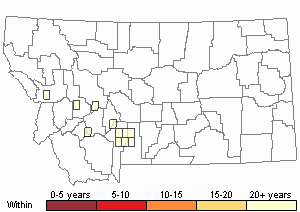
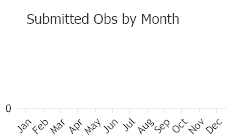
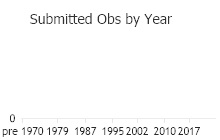 (Observations spanning multiple months or years are excluded from time charts)
(Observations spanning multiple months or years are excluded from time charts)
Habitat
This species inhabits rocky and gravelly areas such as rockslides, cliffs, rocky ravines, talus slopes and sometimes roadsides. Most preferred habitats are scantily vegetated, but with numerous forbs such as Phlox sp., Penstemon sp., and Lupinus sp. habitats where grasshopper diversity and abundance are generally low (Otte 1984, and Vickery and Kevan 1985).
Food Habits
The Undulant-winged Grasshopper is a mixed feeder of grasses and forbs.
Reproductive Characteristics
No detailed studies have been found in the literature relative to courtship and mating for this species beyond the male flight displays (refer to section on Communicative behavior/Crepitation).
Stewardship Responsibility
References
- Literature Cited AboveLegend:
 View Online Publication
View Online Publication Capinera, J.L., R.D. Scott, and T.J. Walker. 2004. Field Guide to Grasshoppers, Katydids, and Crickets of the United States. Ithaca, NY. Cornell University Press.
Capinera, J.L., R.D. Scott, and T.J. Walker. 2004. Field Guide to Grasshoppers, Katydids, and Crickets of the United States. Ithaca, NY. Cornell University Press. Helfer, J.R. 1971. How to Know the Grasshoppers, Crickets, Cockroaches, and Their Allies. Revised edition (out of print), Mineola, NY: Dover Publications.
Helfer, J.R. 1971. How to Know the Grasshoppers, Crickets, Cockroaches, and Their Allies. Revised edition (out of print), Mineola, NY: Dover Publications. Newton, R.C. and A.B. Gurney. 1956-1957. Distribution maps of range grasshopper in the United States. USDA Cooperative Economic Inst. Rep. 6 & 7.
Newton, R.C. and A.B. Gurney. 1956-1957. Distribution maps of range grasshopper in the United States. USDA Cooperative Economic Inst. Rep. 6 & 7. Otte, Daniel. 1981. The North American Grasshoppers. Volume 1. Acrididae (Gomphocerinae and Acridinae). Harvard University Press. 275 pp.
Otte, Daniel. 1981. The North American Grasshoppers. Volume 1. Acrididae (Gomphocerinae and Acridinae). Harvard University Press. 275 pp. Otte, Daniel. 1984. The North American Grasshoppers Volume II. Acrididae (Oedipodinae). Harvard University Press. 366 pp.
Otte, Daniel. 1984. The North American Grasshoppers Volume II. Acrididae (Oedipodinae). Harvard University Press. 366 pp. Vickery, V. R. and D. K. M. Kevan. 1985. The grasshopper, crickets, and related insects of Canada and adjacent regions. Biosystematics Research Institute, Ottawa, Ontario. Publication Number 1777. 918 pp.
Vickery, V. R. and D. K. M. Kevan. 1985. The grasshopper, crickets, and related insects of Canada and adjacent regions. Biosystematics Research Institute, Ottawa, Ontario. Publication Number 1777. 918 pp.
- Additional ReferencesLegend:
 View Online Publication
View Online Publication
Do you know of a citation we're missing? Hebard, M. 1928. The Orthoptera of Montana. Proceedings of the Academy of Natural Sciences of Philadelphia, Vol. 80:211-306.
Hebard, M. 1928. The Orthoptera of Montana. Proceedings of the Academy of Natural Sciences of Philadelphia, Vol. 80:211-306. Scott, R.D. 2010. Montana Grasshoppers, Katydids, and Crickets A Pictorial Field Guide to the Orthoptera. MagpieMTGraphics, Billings, MT.
Scott, R.D. 2010. Montana Grasshoppers, Katydids, and Crickets A Pictorial Field Guide to the Orthoptera. MagpieMTGraphics, Billings, MT.
- Web Search Engines for Articles on "Undulant-winged Grasshopper"
- Additional Sources of Information Related to "Insects"





